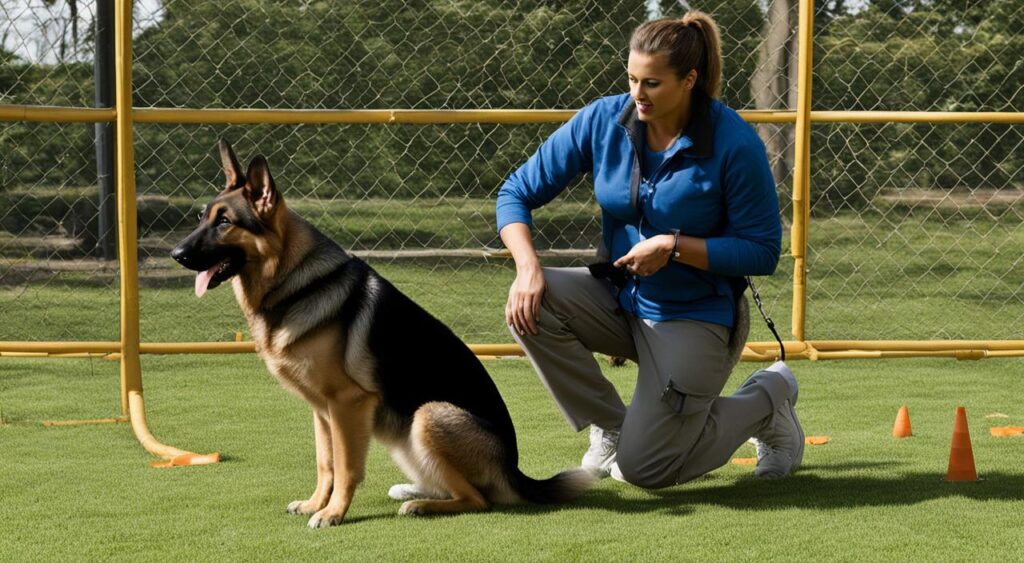Are you passionate about working with dogs and helping them improve their behavior? If so, a career in dog training may be the perfect fit for you. Dog training is a fulfilling and rewarding profession that allows you to make a positive impact on the lives of dogs and their owners.
To become a successful dog trainer, it’s important to follow a structured career path and obtain the necessary training and certification. In this article, we’ll guide you through the essential steps to becoming a professional dog trainer, including gaining hands-on experience and pursuing specialized training.
Key Takeaways:
- The dog training career path requires training and certification.
- Gaining hands-on experience is crucial to success as a dog trainer.
- Choosing the right dog training program can make all the difference.
- Advanced training techniques and specializations can enhance your skills and opportunities.
- Building a strong network and staying up-to-date with industry trends are important for success in the dog training industry.
Steps to Becoming a Dog Trainer
Becoming a professional dog trainer requires completing essential steps that prepare you for the career. These steps include researching and enrolling in accredited and reputable dog training courses, enrolling in a dog training school, and gaining hands-on experience. Here are the key steps to follow to become a successful dog trainer:
- Research and choose the right dog training courses: Conduct thorough research, read reviews, and ask for recommendations to find reputable dog training courses that align with your interests and budget. Courses typically cover fundamental dog behavior, obedience training, and dog training techniques. Completing a course provides you with a foundation to become a professional dog trainer.
- Enroll in a dog training school: Enrolling in a dog training school enhances your knowledge and skills. Consider the location, curriculum, cost, and certification to choose a program that meets your needs. Accredited schools provide rigorous course work, real-world experiences, and mentorship from experienced professionals. Completing a dog training school program boosts your chances of getting hired by employers or starting your own business.
- Gain hands-on experience: Nothing beats hands-on experience in the dog training field. Gain experience by volunteering at animal shelters, apprenticeships with experienced trainers, offering low-cost dog training services, or working with clients’ dogs. Building your experience enhances your credibility, reputation, and increases your chances of earning a good income as a professional dog trainer.
Follow these essential steps to ensure that you become a professional dog trainer who can apply dog training techniques, create strong relationships with clients, and can work as a professional dog trainer.
Understanding Dog Behavior and Obedience Training
Effective dog training requires an understanding of canine behavior and obedience training techniques. This knowledge enables pet trainers to communicate effectively with dogs and establish healthy relationships built on trust, respect, and positive reinforcement.
Dog behavior training is the cornerstone of any successful training program. It involves teaching dogs desirable behavior while eliminating problematic behaviors. This training ensures that dogs aren’t destructive, aggressive, or disruptive. Positive reinforcement techniques are vital for this type of training as they reward the desired behavior and reinforce positive behavior patterns.
Dog obedience training is another crucial component of successful dog training. It involves teaching dogs a range of commands, including sit, stay, come, and heel. These commands train dogs to obey orders from their owners, making them more obedient and less troublesome.
Some of the dog training techniques that promote positive behavior include clicker training, positive reinforcement, and model-rival training. Clicker training involves using a clicker to signal positive reinforcement as a reward for desirable behavior. Positive reinforcement involves giving treats, verbal praise, and petting to motivate dogs to repeat positive behaviors. Model-rival training teaches desirable behaviors by using another dog that the trainee dog can mimic.
Overall, understanding dog behavior and obedience training techniques is vital for effective dog training. A thorough understanding of these concepts helps build a bond with dogs, leading to obedient, happy, and well-adjusted dogs.

Choosing the Right Dog Training Program
Becoming a professional dog trainer requires a combination of knowledge and hands-on experience, and choosing the right dog training program is paramount. Factors to consider when selecting a program include the course content, duration, schedule, cost, accreditations, and certifications.
Accreditation and certification ensure that the program meets industry standards and that you gain the necessary knowledge and skills to become a professional dog trainer.
When evaluating different dog training courses, be sure to check if they offer certification upon completion. Certification can provide credibility and increase job prospects, which is vital in the competitive dog training industry.
Pro tip: Research the school’s reputation by reading reviews and asking for referrals from friends and colleagues. A reputable institution is critical for a successful and rewarding dog training career.
Gaining Hands-on Experience
Aspiring dog trainers need to gain hands-on experience to advance their dog training career. Volunteering at animal shelters can provide opportunities to work with a variety of dogs and learn about their different personalities and behaviors. Apprenticing with experienced trainers can offer valuable mentorship and guidance in mastering dog training techniques. Additionally, working with clients’ dogs can enhance skills and credibility by demonstrating practical experience as a professional dog trainer.
To stand out in the competitive dog training industry, it’s essential to have a diverse range of experiences. Professional dog trainers can expand their knowledge and skills by attending seminars and workshops, as well as pursuing additional certifications. These activities not only add value to their skills but also demonstrate a commitment to continuous education in the field.
By gaining hands-on experience, dog trainers can master the art of dog training, build a strong reputation, and develop a loyal clientele. As experience is essential for success in this career, it’s crucial to take advantage of every opportunity to work with dogs and learn from experienced professionals.
Advanced Training Techniques and Specializations
As a professional dog trainer, it is essential to have a deep understanding of advanced dog training techniques and have expertise in specific areas of specialization. This requires pursuing additional education and training beyond dog training courses and on-the-job experience.
Benefits of Pursuing Specialized Training
By pursuing specialized training, you can develop a unique skill set, making it easier to stand out in a crowded market. Additionally, it allows you to offer services that go beyond basic obedience training, improving your credibility and earning potential.
Here are some areas of specialization that professional dog trainers commonly pursue:
| Specialization | Description |
|---|---|
| Service Dog Training | Training dogs to assist individuals with disabilities or health conditions such as visual impairments, hearing loss, epilepsy, and more. |
| Therapy Dog Training | Training dogs to provide emotional support to individuals in hospitals, nursing homes, schools, and other settings. |
| Competition Obedience Training | Training dogs to compete in obedience trials, which assess the dog’s obedience and ability to follow commands. |
Advanced Dog Training Techniques
Advanced dog training techniques involve a deep understanding of canine behavior and psychology and are used to address more complex behavioral issues. Below are a few examples of advanced techniques:
- Positive Reinforcement: A training method that rewards good behavior with treats, toys, or praise to reinforce that behavior.
- Counter-Conditioning: A technique used to modify negative behavior by associating it with a positive experience.
- Clicker Training: Uses a clicker to mark desired behavior, which is then immediately followed by a reward. It helps in teaching complex commands and tricks.
Staying up-to-date with the latest training techniques and industry trends is essential for any professional dog trainer who wants to be successful in their career.
Tips for Success in the Dog Training Industry
Now that you have embarked on your journey to becoming a professional dog trainer, what are the steps you can take to excel in this rewarding field? Here are some dog training tips that can help you achieve success:
- Build a Strong Network: Connect and collaborate with other trainers, pet trainers, and veterinarians to expand your knowledge of the industry.
- Stay Up-to-Date with Industry Trends: Keep yourself informed on the latest developments in dog training, attend seminars and conferences, subscribe to industry publications, and join online forums dedicated to dog training.
- Continuously Expand Your Knowledge: Learn new dog training techniques, understand different dog breeds, and explore various training methodologies through ongoing education, online courses, and certification programs.
- Focus on Customer Service: Develop excellent communication and interpersonal skills to connect with clients, maintain a positive reputation, and increase referrals.
By following these dog training tips, you can establish yourself as a skilled and reliable professional dog trainer, delight clients, and build a successful dog training career.

Conclusion
Now that you have a comprehensive understanding of the dog training career path, you are one step closer to achieving your dream of becoming a professional dog trainer. Remember that obtaining a dog training certification is crucial to building your credibility and advancing in your career.
Follow the essential steps, such as enrolling in reputable dog training courses and gaining hands-on experience, to hone your skills and become a successful professional dog trainer. Additionally, it’s crucial to keep up with industry trends and pursue specialized training to stay competitive in the field.
Ultimately, the dog training career can be incredibly rewarding, both personally and professionally. By embracing your passion for working with dogs and committing to ongoing education and improvement, you can create a fulfilling, lifelong career as a professional dog trainer. Good luck!
FAQ
How do I become a professional dog trainer?
To become a professional dog trainer, you should start by gaining knowledge and experience in dog training techniques. Enroll in reputable dog training courses and consider obtaining certification from recognized organizations. Additionally, gaining hands-on experience by working with dogs and apprenticing with experienced trainers is crucial for your career development.
What is the importance of dog training certification?
Dog training certification is important for establishing your credibility and expertise as a professional dog trainer. It demonstrates that you have acquired the necessary knowledge and skills to handle various dog training scenarios. Certification can also enhance your chances of getting hired by dog training facilities or attracting clients as an independent trainer.
How can I choose the right dog training program?
When choosing a dog training program, consider factors such as accreditation, curriculum, and practical experience opportunities. Look for programs that offer a comprehensive understanding of dog behavior and training techniques. Research schools or institutions that have a good reputation and positive reviews from previous students. Additionally, consider seeking guidance from experienced professionals in the field.
Why is it important to understand dog behavior and obedience training techniques?
Understanding dog behavior and obedience training techniques is crucial for effective communication and building a strong relationship with dogs. It enables you to address behavioral issues, teach commands, and create a harmonious living environment. By understanding their behavior, you can tailor your training methods to individual dogs, ensuring the best results.
How can I gain hands-on experience in dog training?
Gaining hands-on experience in dog training is essential for honing your skills and advancing your career. Consider volunteering at local animal shelters or rescues to work with different breeds and temperaments. Apprenticing with experienced trainers can provide valuable mentorship and guidance. Additionally, offer your services to friends, family, and clients to gain practical experience with a variety of dogs.
What are some advanced training techniques and specializations in dog training?
Advanced training techniques in dog training include specialized areas such as service dog training, therapy dog training, and competition obedience training. These specializations require additional training and knowledge beyond basic obedience. Pursuing advanced training can open up new opportunities and allow you to work with dogs in specialized roles.
What are some tips for success in the dog training industry?
To succeed in the dog training industry, build a strong network of contacts, including fellow trainers and professionals in related fields. Stay updated with industry trends and advancements by attending seminars, workshops, and conferences. Continuous education and learning will ensure that you stay ahead of the curve. Finally, provide excellent customer service to your clients, as word-of-mouth referrals can significantly contribute to your success.




